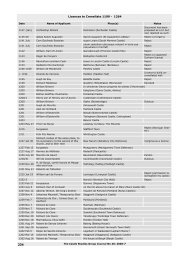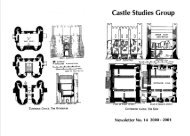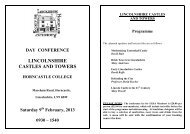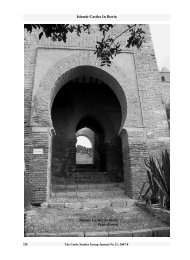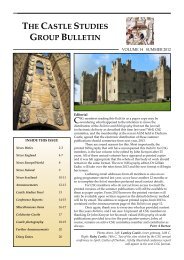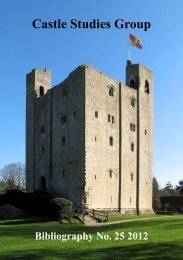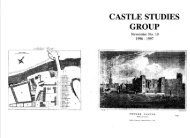Machicolation: some postscripts. - Castle Studies Group
Machicolation: some postscripts. - Castle Studies Group
Machicolation: some postscripts. - Castle Studies Group
You also want an ePaper? Increase the reach of your titles
YUMPU automatically turns print PDFs into web optimized ePapers that Google loves.
<strong>Machicolation</strong>: <strong>some</strong> <strong>postscripts</strong>.<strong>Machicolation</strong>: Some <strong>postscripts</strong>John HarrisSince I wrote the piece “<strong>Machicolation</strong>:History and Significance” 1 I have comeacross <strong>some</strong> examples of machicolationwhich, though they may not alter any of thearguments discussed in that piece, do addinteresting detail. The first example comesfrom the earliest days of castle building andtouches on the invention of machicolation.It has long been known that up inthe intrados of the two flanking arches ofthe three on the west front of Lincoln Cathedral,there are slots that look very likeslot machicolation, but there has been surprisinglylittle comment on them. Theseslots are accessed from small chambers atsecond floor level, which reinforces theidea that they could serve as machicolation;it is assumed that there was a similar slotover centre portal, which is of course higherthan the others and has been altered;access to this could have been from a wallwalkat parapet level.In 1986, an article by RichardGem 2 was published which suggested thatoriginally the west end of the cathedral wasindeed fortified. This first phase of thework was begun by Bishop Remigius in1072 and consecrated in 1092. It may seemsurprising that a cathedral should be fortified,especially when it is so close to a royalcastle of much the same date, but such atheory does explain these slots, for which itis difficult to find any convincing explanationother than machicolation. Other aspectsof the building, in particular whatmust be a latrine, suggest a non-ecclesiasticalpurpose.In an article published in 1997,David Stocker and Alan Vince 3 take upGem’s idea and put it into the context of theevolution of the Roman town into the mediaevalUpper City of Lincoln. They argueconvincingly that for a time the buildingthat is now the west end of the cathedralserved as the keep of a castle built byBishop Remigius in his rôle as temporallord. When Bishop Alexander moved themilitary base of the bishop’s secular responsibilitiesto Newark in the secondquarter of the 12th century, the keep wasincorporated into a cathedral nave, whichwas then rebuilt after a fire in the 1140s.They also make a convincing case for thetower being completed near the start ofRemegius’s building programme, perhapsby 1075, so this machicolation (and indeedthe keep itself) is very early.Much of the argument aboutwhether this is <strong>some</strong> kind fortified westworkto a cathedral or a separate bishop’skeep lies outside the scope of this piece. 4Few writers seem to regard the machicolationas remarkable in itself, apart from itsimportance in suggesting the defensiblenature of the building, but I think it is andit seems clear that the idea of slot machicolationexisted in England nearly a centurybefore we find it in a more developed format, say, Krak des Chevaliers, and this seemsworthy of comment. It has been suggested 5that one possible origin of slot machicolationis the double gateways formed of twoseparated planes found in Moorish Spain asearly as the mid-10th century.Here in Lincoln we have machicolationused in association with gateways; itseems a simple connection. But BishopRemigius was a Norman; he had held postsin Fécamp and Dorchester but seems tohave had no connection with MoorishSpain, or with what is now Iraq, where slotmachicolation can be found dating from thelate 8th century. But might his designerhave been more cosmopolitan than he was?It would be exciting to find that the bishophad <strong>some</strong>one in his retinue with experienceof military architecture in Spain.Stocker and Vince draw parallelsbetween this Lincoln tower and the WhiteTower in London as examples of the earliestphase of Norman hall-keep building inThe <strong>Castle</strong> <strong>Studies</strong> <strong>Group</strong> Journal No 24: 2010-11 214



